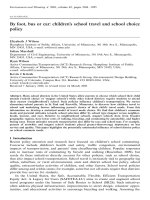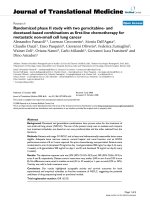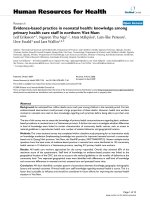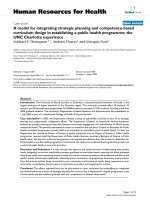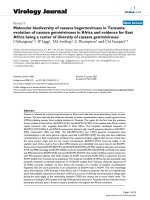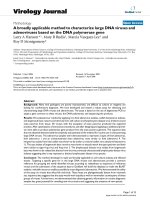GIS and evidence based policy making
Bạn đang xem bản rút gọn của tài liệu. Xem và tải ngay bản đầy đủ của tài liệu tại đây (24.49 MB, 370 trang )
GIS
and Evidence-Based
Policy Making
ß 2007 by Taylor & Francis Group, LLC.
I N N O VA T I O N S
I N
G I S
SERIES EDITORS
Jane Drummond
University of Glasgow, Glasgow, Scotland
Bruce Gittings
University of Edinburgh, Edinburgh, Scotland
Elsa João
University of Strathclyde, Glasgow, Scotland
GIS for Environmental Decision-Making
Edited by Andrew Lovett and Katy Appleton
GIS and Evidence-Based Policy Making
Edited by Stephen Wise and Max Craglia
Dynamic and Mobile GIS: Investigating Changes in Space and Time
Edited by Jane Drummond, Roland Billen, Elsa João, and David Forrest
ß 2007 by Taylor & Francis Group, LLC.
I N N O V A T I O N S
I N
G I S
GIS
and Evidence-Based
Policy Making
Edited by
Stephen Wise
Max Craglia
Boca Raton London New York
CRC Press is an imprint of the
Taylor & Francis Group, an informa business
ß 2007 by Taylor & Francis Group, LLC.
CRC Press
Taylor & Francis Group
6000 Broken Sound Parkway NW, Suite 300
Boca Raton, FL 33487-2742
© 2008 by Taylor & Francis Group, LLC
CRC Press is an imprint of Taylor & Francis Group, an Informa business
No claim to original U.S. Government works
Printed in the United States of America on acid-free paper
10 9 8 7 6 5 4 3 2 1
International Standard Book Number-13: 978-0-8493-8583-4 (Hardcover)
This book contains information obtained from authentic and highly regarded sources. Reprinted
material is quoted with permission, and sources are indicated. A wide variety of references are
listed. Reasonable efforts have been made to publish reliable data and information, but the author
and the publisher cannot assume responsibility for the validity of all materials or for the consequences of their use.
No part of this book may be reprinted, reproduced, transmitted, or utilized in any form by any
electronic, mechanical, or other means, now known or hereafter invented, including photocopying,
microfilming, and recording, or in any information storage or retrieval system, without written
permission from the publishers.
For permission to photocopy or use material electronically from this work, please access www.
copyright.com ( or contact the Copyright Clearance Center, Inc. (CCC)
222 Rosewood Drive, Danvers, MA 01923, 978-750-8400. CCC is a not-for-profit organization that
provides licenses and registration for a variety of users. For organizations that have been granted a
photocopy license by the CCC, a separate system of payment has been arranged.
Trademark Notice: Product or corporate names may be trademarks or registered trademarks, and
are used only for identification and explanation without intent to infringe.
Library of Congress Cataloging-in-Publication Data
GIS and evidence-based policy making / editors Stephen Wise and Max Craglia.
p. cm. -- (Innovation in GIS)
Includes bibliographical references and index.
ISBN 978-0-8493-8583-4 (alk. paper)
1. Geographic information systems--Government policy. 2. Geospatial data. 3.
Information storage and retrieval systems--Geography--Government policy. I.
Wise, Stephen. II. Craglia, Massimo. III. Title. IV. Series.
G70.212.W57 2008
910.285--dc22
Visit the Taylor & Francis Web site at
and the CRC Press Web site at
ß 2007 by Taylor & Francis Group, LLC.
2007029937
Contents
Preface
Editors
Contributors
GISRUK Committees and Sponsors
Part I
C ollecting E vidence
Section I
Data Issues
1.
National Spatial Data Infrastructure Phenomeno n
Ian Masser
2.
Urban Neighborhood Pattern Recognition Using High
Spatial Resolution Remotely Sensed Data and Point-Based
GIS Data Sources
Victor Mesev and Paul McKenzie
3.
Geodemogr aph ics
Richard Webber
Se ction I I
M eth odo log i cal A dv an ces
4.
Routing o ut the Hot Spots: Toward Us ing GIS
and C rime-Place Principles to Examine Crim inal
Damage to Bus S helters
Andrew Newton
5.
Policy Implications of Pockets of Deprivation
in Sc otland
Daniel Exeter, Robin Flowerdew, and Paul Boyle
6.
Crime Map A nalyst: A GIS to Support Local-Area
Crime Reduction
Paul Brindley, Max Craglia, Robert P. Haining,
and Young-Hoon Kim
ß 2007 by Taylor & Francis Group, LLC.
7.
Using GIS to Identify Social V ulnerability
in Areas of the United K ingdom That Are at R isk
from Flooding
Tom Kieron Whittington
8.
Pattern Identification in Public Health Data Sets:
The P otential Offered by Graph Theory
Peter A. Bath, Cheryl Craigs, Ravi Maheswaran,
John Raymond, and Peter Willett
9.
Residential P roperty Utilization: Monitoring
the Governm ent Intensification Agenda
Peter Bibby
Part II
Maki ng Pol icy
Section I
Engaging with Polic y-Makers
10.
A pplication o f GIS to Support Land
Administration S ervices in Ghana
Isaac Karikari, John Stillwell, and Steve Carver
11.
S patial Methodologies to S upport Postwar
Rec onstruction
Sultan Z. Barakat, Adrijana Car, and Peter J. Halls
12.
M alta NPI P roject: Developing a Fully
Accessible I nformation System
Malcolm Borg and Saviour Formosa
1 3.
A GIS-Base d Me t ho do lo gy to Su pp ort t he
Development of L ocal Rec ycling Strategies
Andrew Lovett, Julian Parfitt, and Gilla Su¨nnenberg
14.
C omparison o f Discrete-Choic e Modeling
and A ccessibility-Based Approaches: A Forest
Rec reation Study
Mette Termansen, Colin J. McClean, and Hans Skov-Petersen
Section II
15.
Engag ing with the Public
E ngagin g C itizens: The B radford C ommunity
Statistics Project
Derek Reeve, Erik Thomasson, Steve Scott,
and Ludi Simpson
ß 2007 by Taylor & Francis Group, LLC.
16.
Public -Oriented Interactive Environmental
Decision Support S ystem
Tan Yigitcanlar
17.
Public Participation in the Digita l A ge:
A Theor etical Approa ch
Robin S. Smith
ß 2007 by Taylor & Francis Group, LLC.
ß 2007 by Taylor & Francis Group, LLC.
Preface
In 1993, the first of the GIS Research U.K. (GISRUK) conferences was held at
the University of Keele. Before that, U.K. GIS conferences had been very
broad-based, bringing together the entire spectrum of people who created
and used spatial data and the software to process the data. While such
conferences were very valuable, it was felt that there was also a need for
an academic conference where the focus would be purely on research. It was
clear from the very first Keele meeting that the GISRUK conference series
was fulfilling a useful function in bringing together researchers from all the
different disciplines that contribute to geographic information science
(GISc) in an informal but stimulating atmosphere. The Sheffield GISRUK
conference in 2002 was the 10th anniversary of the conference series, and
thus represented a chance to look back at the first 10 years and look forward
to the future.
GISRUK can be proud of its achievements in the first 10 years of its
existence. Attendance at the conferences has grown and become more
international. One of the original aims was to make GISRUK a forum in
which young researchers could be encouraged and welcomed, and this has
grown to become one of the most distinctive features of the conferences.
Every year there is a young researchers’ forum, which takes place immediately before the main conference and allows those starting out on research
careers in GIS to meet each other and share their experiences and to receive
advice and feedback from experienced researchers. There is a special prize
for the best paper presented by a young researcher. The success of this
approach to inducting newcomers into the GIS research community can be
judged by the fact that a previous winner of this prize is now a member of
the national steering committee.
One of the interesting things about GISRUK is that there is no formal
association behind the conference series. A national steering committee
exists, to provide some continuity from year to year, but each conference
is effectively autonomous and the local organizing committees have
the freedom to run things as they see fit. During the Sheffield conference,
one of the invited speakers, Professor Ian Masser, made the suggestion that
GISRUK might seek to take on the role of representing the views of the U.K.
GIS research community more widely in the way that AGILE does within
Europe. This generated a lively discussion both during and after the conference session, which is after all what you want from a keynote talk! It was
decided that in order to take on this role, GISRUK would have to constitute
itself more formally because presently the steering committee is unelected
ß 2007 by Taylor & Francis Group, LLC.
and thus has no mandate to represent anyone. The consensus was that this
was not the way people wished to see GISRUK develop, not least because it
was felt that the Association of Geographic Information (AGI) is already
constituted in a way that allows it to represent the views of its members,
including academics. However, one of the results of the discussions was an
agreement to forge closer links between the AGI and GISRUK.
One of the main outputs of the GISRUK conferences has been the annual
Innovations in GIS volume. In keeping with the spirit of review, this volume
represents something of a change compared with previous volumes. Early
volumes in the series presented a selection of the best papers from each
conference, covering the full range of GIS. However, more recently the trend
has been to produce a volume more focused on one of the main themes
of the conference. In this volume we have extended this process. The bulk of
the papers collected here are full versions of papers that were presented at
Sheffield in 2002. However, in order to produce a book that is a more
comprehensive review of the state of the art of research into evidence-based
policy making, we have also invited additional contributions from leading
researchers in this area.
The papers in the first half of the book are concerned with collection of
the evidence that underpins policy making. This has been split into two
sections—the collection of data and the methods for analyzing the data to
produce new information.
Ian Masser sets the scene with the first paper in this section by stressing the
importance of location as a key factor in policy making at the national level.
One of the implications of this is that spatial databases need to be compiled
and made available at the national level. As Ian demonstrates, the ways in
which this issue has been tackled vary widely between countries, with
the variations dictated as much by differences in the approach to national
government as by differences in the availability of data. One general pattern
that does emerge, however, is a distinct difference between the earlier
initiatives in this area, which were dominated by the efforts of data producers
to complete or extend their data holdings, to current initiatives that are lead
by a wider range of stakeholders and are more focused on providing users
with access to data, and connecting distributed data repositories.
The increasing availability of data is partly due simply to the passage of
time, with various data capture projects increasingly turning a paper archive into a digital one. Moreover, it is also due to technological advances,
both in sources of data and in methods for analyzing these sources.
Nowhere is this more true than in the area of Earth observation. The
resolution of early remote sensing satellites (in the civilian domain at
least) meant that while it was possible to distinguish the built from the
natural environment, it was not possible to resolve the detailed variation
within the built environment. However, recent satellite platforms have
changed that and it is now possible to resolve individual buildings and
plots of land on satellite imagery. The challenge is to automate the recognition of the individual features and to try and make inferences about land
ß 2007 by Taylor & Francis Group, LLC.
use, as opposed to simply determining land cover. This is the subject of
the second chapter by Victor Mesev and Paul McKenzie, in which one
possible approach to classifying urban land-use patterns by using relatively
simple spatial statistics on the pattern of buildings in an area is reviewed.
These statistics are shown to distinguish reasonably well between different
patterns of residential developments in a number of cities in the U.K.
Inference is of course an important characteristic of geodemographics, in
which neighborhoods are classified by drawing inferences from a series of
statistics on the people who live there. The pioneer of this approach, Richard
Webber, concludes the first half of Part I with an overview of geodemographics. He points out that this technique was originally developed to help
target policy making in the 1970s, and only later ‘‘escaped’’ into the commercial sector, where it is much better known. Originally developed in the
U.S. and the U.K., it is now used in 19 other countries around the world.
Despite differences in the categories in which they are used, they show some
constant factors, such as the emergence of a group in the U.K. who would be
called ‘‘young upwardly-mobile professionals,’’ or yuppies as they used to
be called in the popular press.
The chapters in Section II of Part I are all concerned with developments in
the methods that can be used to undertake the analysis of spatial data for
the purposes of informing policy. Health and crime are the two areas in
which spatial analysis has a long history and it continues to play an important role, and half the papers in this section deal with these two topics. Crime
is the subject of the paper by Andrew Newton. It has long been recognized
that the occurrence of crime has a strong spatial pattern, governed at the
broad scale by the distribution of those who take part in criminal activity
and at the local scale by the location of potential targets for criminal
activity. Newton’s paper extends this focus in two ways. First, new technology such as GPS may allow us to begin analyzing crimes in which the
locus of the crime is not fixed but mobile, such as crime on public transport
systems, although little work has been done on this to date. Second, Newton
argues that certain locations may act as attractors to crime and takes as an
example of this, criminal damage to bus shelters. His analysis reveals a
tendency for occurrences of damage to be clustered. The clustering shows
some connection with parts of the city where crime levels are higher than
average, but also shows an additional degree of clustering that seems to
suggest that certain locations are the focus of increased criminal activity.
Patterns of crime and poor health are often strongly linked to material
deprivation and it could be argued that in a capitalist society,
material deprivation is the single most important determinant of social
well-being. For reasons of confidentiality, deprivation is normally estimated
on an areal basis, which raises all the well-known problems connected with
modifiable areas. In Chapter 5, Daniel Exeter, Robin Flowerdew, and Paul
Boyle consider the extent to which this approach hides small pockets of
deprivation within larger areas. They take Scotland as their example, and by
comparing deprivation levels at the scale at which policy decisions are
ß 2007 by Taylor & Francis Group, LLC.
made with the finer scale of the census output areas, they identify a number
of pockets of deprivation that are overlooked in policy making. Somewhat
surprisingly, these are not in rural areas, where this problem is normally
thought to be most acute, but in suburban areas.
Chapter 6 brings us back to crime with a paper by Paul Brindley, Max
Craglia, Robert Haining, and Young-Hoon Kim on the development of
methods for identifying levels of repeat victimization from crime statistics.
There is a technical element to this problem, concerned with how you
identify that the same person or property has been the victim of crime,
when the reporting of the location of the crime may differ between incidents. What is equally interesting in the context of this volume is that the
techniques that were developed to solve this problem had to be appropriate
for use by police officers with no expertise in spatial analysis and only
minimal training in the new software. This raises an issue that is more
thoroughly explored in the second half of the book, which is that if GIS is
to make any contribution to evidence-based policy making, such systems
must be designed with the potential users in mind.
One of the key elements GIS brings to the analysis of spatial data, of
course, is the ability to bring together multiple sets of information, using
location as the linking mechanism. There has been a great deal of interest in
the U.K. in recent years in the apparently increased incidence of lowland
flooding, which many believe to be linked to the first signs of global warming, and a good deal of work on the prediction of which areas are likely to be
affected. The focus of much of this work has been on the potential damage to
property, the assumption being that as long as this can be avoided or
minimized, the inhabitants will be able to take care of themselves. Tom
Whittington’s paper in Chapter 7 makes the key point that the extent to
which this is a reasonable assumption depends on what he terms the social
vulnerability of the inhabitants, a term which covers a whole range of
factors that determine how vulnerable people are to a crisis, ranging
from their mobility to their ability to withstand economic loss. As an
example of how these ideas might be carried out in practice, an index of
social vulnerability is constructed from readily available data and combined
with a simple model of flooding.
Techniques developed in one field of endeavor can often be applied to
other fields, as witnessed by the fruitful cross-fertilization between methods
for analyzing patterns of crime and health. As GIS users we are all well used
to thinking in spatial terms, but we normally interpret the term spatial in the
narrow sense of referring to some portion of the Earth’s surface. However,
analysis that involves spatial relationships exists in other disciplines too,
including computational chemistry where the relationships are between the
elements of molecules and compounds. Patterns and spatial relationships
are important in determining chemical properties, and thus computational
chemists have developed powerful tools to describe patterns and match
them with one another. Peter Bath, Cheryl Craigs, Ravi Maheswaran, John
Raymond, and Peter Willett illustrate how this approach can be applied to
ß 2007 by Taylor & Francis Group, LLC.
geographical space in order to search for patterns. They take the example of
searching for patterns in the occurrence of ill health and illustrate how the
technique makes it simple to search for patterns that would otherwise be
difficult to identify using conventional GIS methods.
The final contribution in this section is the chapter from Peter Bibby
which forms a nice junction between the two halves of the book since
he describes not only some innovative technical approaches but also considers the broader implications of using GIS to provide evidence for policy
making. Peter considers the U.K. government’s policy of keeping new
housing development away from greenfield sites, by intensifying urban
areas, using brownfield sites, and converting existing buildings. The implementation and monitoring of this policy are relatively straightforward using
standard GIS techniques—for example, overlaying the location of new
building plots onto urban polygons reveals that, in the 1990s, 57% of new
buildings fell within urban areas. However, this relies on a simple view of
urban areas defined crisply as polygons. By applying natural languageprocessing techniques to the national address file, Peter was able to create
a more subtle representation of the settlement pattern of the U.K., which
suggests that even more development is taking place in urban areas than the
standard analysis would suggest.
Section I of Part II contains five chapters discussing the relationships
between GIS technology and methods and policy making in public administration from different perspectives.
Chapter 10 by Isaac Karikari, John Stillwell, and Steve Carver emphasizes
that the implementation of GIS=LIS is not just a technical issue, but primarily involves people, organizations, and adaptation of the technology and
working practices to the local context. This applies all the more in developing countries where the projects are often parachuted by donor agencies and
then not followed up and maintained. Hence this chapter makes the
important point that technology transfer needs to be human-centered and
driven by local staff with the necessary technical and organizational skills.
Couched within the broad theoretical framework of sociotechnical design,
the authors describe the prototype GIS developed for the Accra Land
Commission Secretariat as a way to elicit feedback from the staff of that
organization and support the process of mutual adaptation between working practices and technology.
The relationship between technology and society is pursued further in
Chapter 11 by Sultan Barakat, Adrijana Car, and Peter Halls in the context of
postwar reconstruction. The quote by Moore and Davis that they refer to:
‘‘Tell me, I forget. Show me, I remember. Involve me, I understand’’ captures the essence of this chapter focusing on GIS and public participation
in the reconstruction effort following natural or man-made disasters,
such as war. The authors make the important point that reconstruction
is more about people and social relations than aid and material goods.
Likewise technology has to fit the social processes and context but can also
offer opportunities to foster dialogues and participation, and support the
ß 2007 by Taylor & Francis Group, LLC.
multilayered decision-making process. The authors then outline a methodology that integrates the contribution of public participation GIS, spatial
decision support systems, artificial intelligence, and expert systems to develop a flexible and dynamic model of the postwar reconstruction process.
This in their view would enable all the stakeholders to explore the potential
impacts of alternative scenarios, increase informed dialogue, and support
the achievement of consensus.
The organizational theme is pursued in Chapter 12 by Malcolm Borg and
Saviour Formosa in describing their major effort in developing the National
Protective Inventory of cultural artifacts in the island of Malta. Malcolm and
Saviour give an excellent account of this project that is of major significance
to improve accessibility and management of the rich historical heritage of
Malta, and from which many lessons can be learned for similar projects in
Europe and beyond. While the technologies deployed to create a spatial
database and make it accessible via Web browser are now mature for this
kind of project, and their opportunities are well illustrated in this chapter,
what is particularly worth noting is the underlying major effort that has
been required to overcome the data hoarding tradition of public administration, and to develop a culture of data sharing. This is a major challenge
that applies to public administration throughout the world and certainly not
just to Malta.
While the previous three chapters emphasized the organizational and
cultural challenges of implementing GIS-based projects in public administration, Andrew Lovett, Julian Parfitt, and Gilla Su¨nnenberg in Chapter 13
show the opportunities for policy making that arise from the development
of long-term partnerships between university-based researchers and local
administrations. This chapter presents an interesting application of GIS to
assess the likely impacts of different refuse collections and recycling strategies needed to meet government targets. The case-study area is South
Norfolk County, which has a well-maintained waste statistics database
(what a rarity!) as well as a history of collaboration with the researchers
based in Norfolk. From these premises, the methodology described in the
chapter is of generic value for other similar types of applications and
alternative strategy assessment, and is therefore of significant value.
The final chapter in this section, by Mette Termansen, Colin McClean and
Hans Skov-Petersen, looks at how GIS can benefit another widely used
analytical approach, discrete choice modelling. This is applied to the modelling of recreational visits to forests in Denmark, using a random utility
model (RUM) with numerous parameters calculated using GIS. Interestingly, the researchers found that the effect of distance on people’s choice
of site is not linear, as is often assumed, but is much stronger when
choosing between nearby locations than when trying to decide between
locations that are all much further away. A number of characteristics of
the area around the forested area, not normally considered in this kind of
analysis, were also significant, with people showing a marked preference
for forests near the coast and in undulating topography. The researchers
ß 2007 by Taylor & Francis Group, LLC.
also developed a completely GIS-based approach but found that while this
was much simpler to implement, it was not able to model the full range of
factors as successfully as the RUM approach.
The last section of the book focuses on the opportunities and challenges of
involving the public through Internet-based spatial technologies, and other
information and communication channels. The development of a shared
understanding among multiple stakeholders and the public of local context,
problems, and opportunities is the theme of Chapter 15 by Derek Reeve,
Erik Thomasson, Steve Scott, and Ludi Simpson. These authors present an
excellent example of a Web-based participatory system designed with the
local community rather than for the community in Bradford, England. The
key feature of the Maps and Stats system is the ability for users to generate
small-area statistics for user-defined areas, which makes it stand out from
the traditional approaches based on predefined administrative areas. As
persuasively argued by the authors, the increased control by users on
what they can get out of this system is a prerequisite to engage the local
community and foster active participation. The development of Maps and
Stats is another good example of partnership between the local authority,
the university, and a not-for-profit community research center, and a model
for others to follow.
Chapter 16, by Tan Yigitcanlar, reviews the mix of technologies and
methods currently available to support public involvement and participation. The community-based Internet GIS he presents encompasses distance
learning modules, analytical modules built around a collaborative GIS
approach, and specific modules to support strategic choice. Web-based
architectures have now matured sufficiently to make the development of
such integrated systems robust enough for wide access and use. The challenge now, as recognized in the discussion of the case study in Tokyo, is to
exploit the opportunities opened up by the technology. This is not trivial
because it requires overcoming the lack of interest shown by the public,
limited vision of public authorities, and skewed availability of the knowledge and skills necessary not only to physically access information and
tools, but more importantly to be able to use them to support meaningful
participation.
The final chapter of this section by Robin Smith takes a broader view of
public participation in the digital age and strives in particular to unpack the
often taken-for-granted view of public participation, which as we all know
is ‘‘good for you.’’ Building on a comprehensive survey of public authority
Web sites in 1999, and a series of case studies, Robin makes the point that
despite the increased opportunities offered by new information and communication technologies (well illustrated in the preceding chapters), the
gap between the rhetoric in support of public participation, stakeholders’
expectations, and outcomes is largely the result of our poor conceptualization and shared understanding of public participation itself. To this
end, Robin articulates five components of public participation, reflecting
differing theoretical constructs (notions), issues, audience, outcomes, and
ß 2007 by Taylor & Francis Group, LLC.
methods. By linking more clearly expected outcomes to the notions of public
participation held by the stakeholders, it is then possible to identify the
methods most suited to engage the relevant audience on a specific issue.
This is an analysis necessary before starting any public participation exercise. Technology comes after theory, not before. An important point always
worth keeping in mind.
Stephen Wise
Max Craglia
ß 2007 by Taylor & Francis Group, LLC.
Editors
Stephen Wise worked in university computer services for 10 years, during
which time he chaired the group that negotiated access to ESRI software for
the U.K. higher education sector and was part of the ESRC-funded Wales
and South-West Regional Research Laboratory. Since 1990 he has lectured in
GIS at the University of Sheffield and is the author of a textbook on GIS
entitled GIS Basics. He is currently a member of the GISRUK national
steering committee and an associate editor of the journal Computers and
Geosciences.
Max Craglia is the research coordinator of the Unit of the Joint Research
Centre of the European Commission that has the responsibility for the technical development of the Infrastructure for Spatial Information in Europe
(http:==inspire.jrc.it). He is also the editor of the International Journal of Spatial
Data Infrastructures Research (http:==ijsdir.jrc.it). Before joining the JRC in
2005, Max was a senior lecturer at the University of Sheffield, teaching GIS
for urban planners and researching areas of spatial data infrastructure
deployment and use, GIS applications for policy analysis, and data policy.
ß 2007 by Taylor & Francis Group, LLC.
ß 2007 by Taylor & Francis Group, LLC.
Contributors
Sultan Z. Barakat Department of Politics, University of York, Heslington,
York, United Kingdom
Peter A. Bath Centre for Health Information Management Research,
Department of Information Studies, University of Sheffield, Sheffield,
United Kingdom
Peter Bibby Department of Town and Regional Planning, University of
Sheffield, Sheffield, United Kingdom
Malcolm Borg
Malta
Ministry for Urban Development and Roads, Valletta,
Paul Boyle School of Geography and Geosciences, University of
St. Andrews, St. Andrews, United Kingdom
Paul Brindley Department of Town and Regional Planning, University of
Sheffield, Sheffield, United Kingdom
Adrijana Car
Austria
Centre for GeoInformatics, Salzburg University, Salzburg,
Steve Carver
Kingdom
School of Geography, University of Leeds, Leeds, United
Max Craglia DG Joint Research Centre of the European Commission,
Institute for Environment and Sustainability, Ispra, Italy
Cheryl Craigs Centre for Reviews and Dissemination, University of York,
York, United Kingdom
Daniel Exeter Section of Epidemiology and Biostatistics, School of Population Health, University of Auckland, Auckland, New Zealand
Robin Flowerdew School of Geography and Geosciences, University of
St. Andrews, St. Andrews, United Kingdom
ß 2007 by Taylor & Francis Group, LLC.
Saviour Formosa Information Resources, Information and Communications Technology, Malta Environment and Planning Authority, St. Francis
Ravelin, Floriana, Malta
Robert P. Haining Department of Geography, University of Cambridge,
Cambridge, United Kingdom
Peter J. Halls Computing Service, University of York, Heslington, York,
United Kingdom
Isaac Karikari
Ghana
Lands Commission Secretariat, Cantonments, Accra,
Young-Hoon Kim Department of Geography Education, Korea National
University of Education, Cheongwon, South Korea
Andrew Lovett School of Environmental Sciences, University of East
Anglia, Norwich, United Kingdom
Ravi Maheswaran Public Health GIS Unit, School of Health and Related
Research, University of Sheffield, Sheffield, United Kingdom
Ian Masser
Taddington, Buxton, Derbyshire, United Kingdom
Colin J. McClean Environment Department, University of York,
Heslington, York, United Kingdom
Paul McKenzie University of Ulster, Coleraine, County Londonderry,
United Kingdom
Victor Mesev Department of Geography, Florida State University,
Tallahassee, Florida
Andrew Newton The Applied Criminology Centre, Department of
Behavioural Sciences, University of Huddersfield, Huddersfield,
United Kingdom
Julian Parfitt
Kingdom
Waste & Resources Action Programme, Banbury, United
John Raymond Department of Information Studies, University of
Sheffield, Sheffield, United Kingdom
Derek Reeve School of Computing and Engineering, University of
Huddersfield, Huddersfield, United Kingdom
ß 2007 by Taylor & Francis Group, LLC.
Steve Scott School of Computing and Engineering, University of
Huddersfield, Huddersfield, United Kingdom
Ludi Simpson Cathie Marsh Centre for Census and Survey Research,
University of Manchester, Manchester, United Kingdom
Hans Skov-Petersen Department of Forest and Landscape, University of
Copenhagen, Copenhagen, Denmark
Robin S. Smith Informatics Collaboratory of the Social Sciences,
University of Sheffield, Sheffield, United Kingdom
John Stillwell
Kingdom
School of Geography, University of Leeds, Leeds, United
Gilla Su¨nnenberg School of Environmental Sciences, University of East
Anglia, Norwich, United Kingdom
Mette Termansen Sustainability Research Institute, School of Earth and
Environment, University of Leeds, Leeds, United Kingdom
Erik Thomasson Research Unit and Consultation Service, City of
Bradford MDC, Bradford, United Kingdom
Richard Webber Centre for Advanced Spatial Analysis, Department of
Geography, University College London, London, United Kingdom
Tom Kieron Whittington GIS and Planning Research Department, Savills
plc, London, United Kingdom
Peter Willett Department of Information Studies, University of Sheffield,
Sheffield, United Kingdom
Tan Yigitcanlar Urban Research Program, Griffith University, Nathan,
Queensland, Australia
ß 2007 by Taylor & Francis Group, LLC.
ß 2007 by Taylor & Francis Group, LLC.
GISRUK Committees and Sponsors
GISRUK National Steering Committee (as of GISRUK 2002)
Jane Drummond
David Fairbairn
Bruce Gittings
Peter Halls
Zarine Kemp
David Kidner
Andrew Lovett
David Miller
Nick Tate
Stephen Wise
Jo Wood
University of Glasgow
University of Newcastle
University of Edinburgh (Chair)
University of York
University of Kent
University of Glamorgan
University of East Anglia
MLURI
University of Leicester
University of Sheffield
City University
GISRUK 2002 Local Organising Committee
Stephen Wise (Chair) Chris Clark
Chris Openshaw
Peter Bibby
Max Craglia
Kate Schofield
Paul Brindley
Young Hoon-Kim Paul White
Rob Bryant
Ravi Maheswaran
GISRUK 2002 Sponsors
GISRUK is extremely grateful for the generous support of the following
sponsors:
Association for Geographic Information
Blackwell Publishers Ltd
CadCorp Ltd
EDINA
Elsevier Science
ESRI (UK) Ltd
Ordnance Survey
Oxford University Press
Taylor & Francis
Wiley Europe Ltd
RRL.net
Quantitative Methods Research Group
ß 2007 by Taylor & Francis Group, LLC.
www.agi.org.uk
www.blackwellpublishers.com
www.cadcorp.com
edina.ed.ac.uk
www.elsevier.nl
www.esriuk.com
www.ordnancesurvey.co.uk
www.oup.co.uk
www.taylorandfrancisgroup.com
eu.wiley.com
www.casa.ucl.ac.uk=qmrg
ß 2007 by Taylor & Francis Group, LLC.
Part I
Collecting Evidence
ß 2007 by Taylor & Francis Group, LLC.

